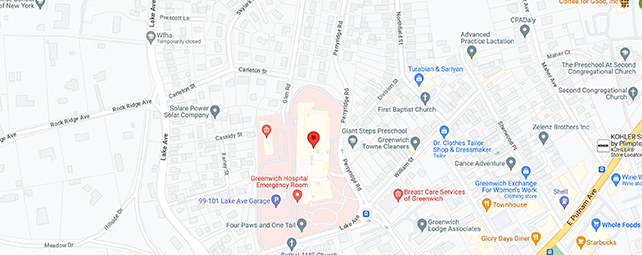Gastric Bypass in Greenwich Hospital
The Laparoscopic Roux-en-Y Gastric Bypass (LRYGB) is considered to be the “gold standard” procedure by the American Society of Bariatric Surgeons (ASBS). This operation is the one most commonly performed and has a proven record of significant weight loss. It includes decreasing the size of the stomach and partially bypassing the small intestine to limit the amount of calorie intake. There are many different techniques that can be used for the LRYGB, all of which are acceptable. With Dr. Neil Floch the procedure is done laparoscopically with 5 to 7 small incisions. A camera called a laparoscope, and long surgical instruments are used while the belly is inflated with carbon dioxide gas. The surgeon then operates while visualizing the internal organs on a high definition television screen. During the LRYGB, a 30-60cc pouch is created by stapling-off the stomach.
The remaining stomach stays alive and intact, and the far end is attached to the small bowel. This “remnant stomach” receives blood and produces digestive stomach acid. A 50cm section of small bowel is then measured, cut, and reattached to the stomach by stapling hand stitching, or a combination of the two. Another 50cm of the small bowel is then attached to the side of the limb to drain the new, small stomach pouch. Food is not absorbed completely because the food and digestive juices are separated for 33% of the length of the bowel. This results in weight loss.
Weight loss from this procedure averages 60-80% loss of excess body weight. The LRYGB is highly effective because patients not only eat less and feel full quickly, but they also do not fully absorb the food they eat. Doing the procedure laparoscopically results in a decreased morbidity and shorter hospital stay when compared to the open procedure. Most patients are discharged home in 2-4 days. An average of 60% to 80% of excess body weight loss can be expected within the first twenty months following this procedure. Most of the loss will occur within the first six months following the surgery. This weight loss can be maintained with post-operative lifestyle changes including diet and exercise.
Advantages:
- Weight loss is quicker than the other procedures
- Nothing is left internally that can slip, break or disintegrate
- Longevity of this operation having been done for over 30 years
- Patients have had better results with total weight loss, long-term weight maintenance, and improved health than those who chose other procedures
Disadvantages:
- Slightly higher complication rate than the other procedures
- Longer recovery period
- A necessity to take vitamin and mineral supplementation for life.
- Dumping syndrome can occur if foods with a sugary content are eaten. This could result in diarrhea, nausea, cramps, cold sweats and chest pain.
Possible Complications:
- Pulmonary embolism
- Deep vein thrombosis (DVT)
- Leakage from bowel
- Abscess
- Hemorrhage
- Bowel Obstruction
- Obstruction of the Stomach Outlet
- Pneumonia
- Wound Infection
- Urinary Tract Infection
- Chronic Nutritional Problems
- Protein Deficiency
- Vitamin and Mineral Deficiency
- Mortality risk is 1 in 1000 depending upon BMI and medical problems.
You are welcome to call our office and we will supply you with a free insurance evaluation. We are here to assist and support you from your initial decision to the actual surgery and the aftercare for your long-term weight loss. Our staff will carry you through the process and minimize your fears, pressures and help you overcome your concerns.
Dr. Neil Floch and his weight loss surgery team makes the long-term care of your weight loss easy and guides you on a lifelong path to freedom from obesity that is safe, enjoyable and satisfying. Come see what we can do for you by scheduling an appointment today.
















